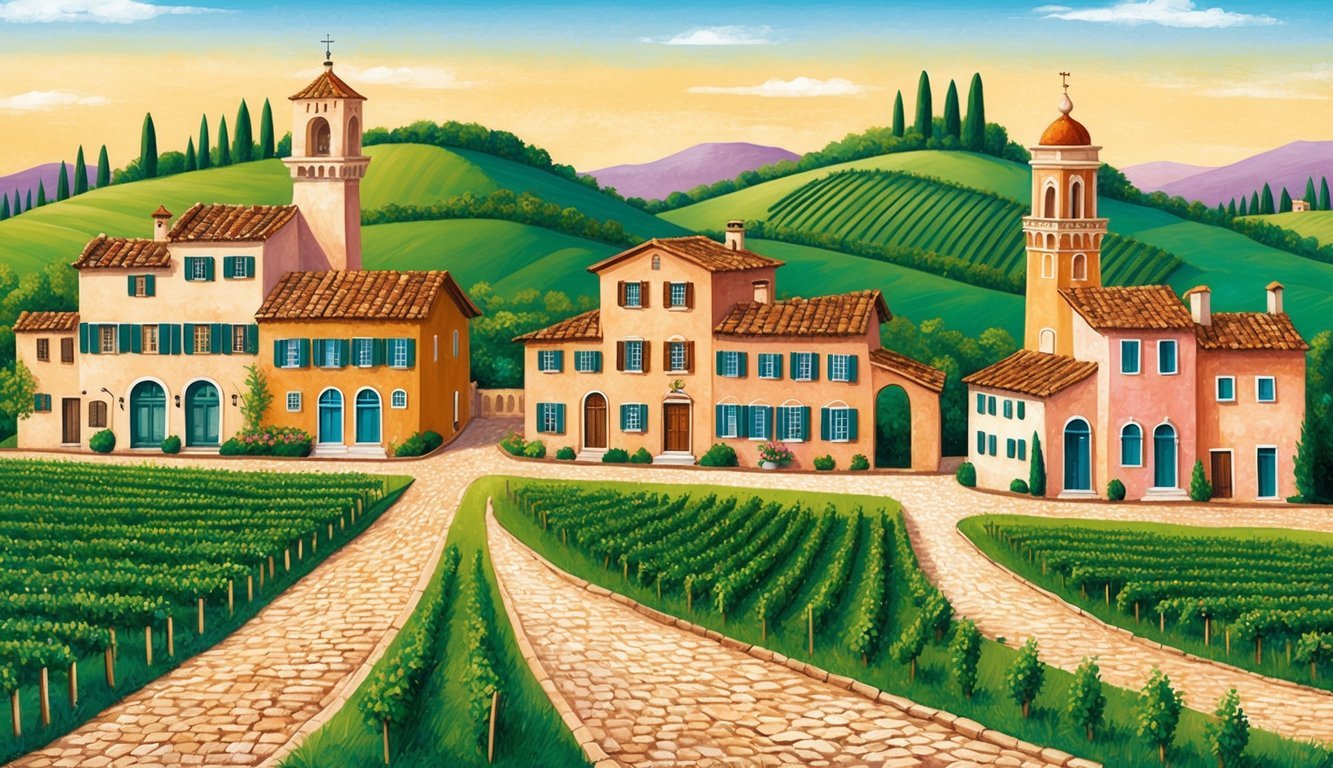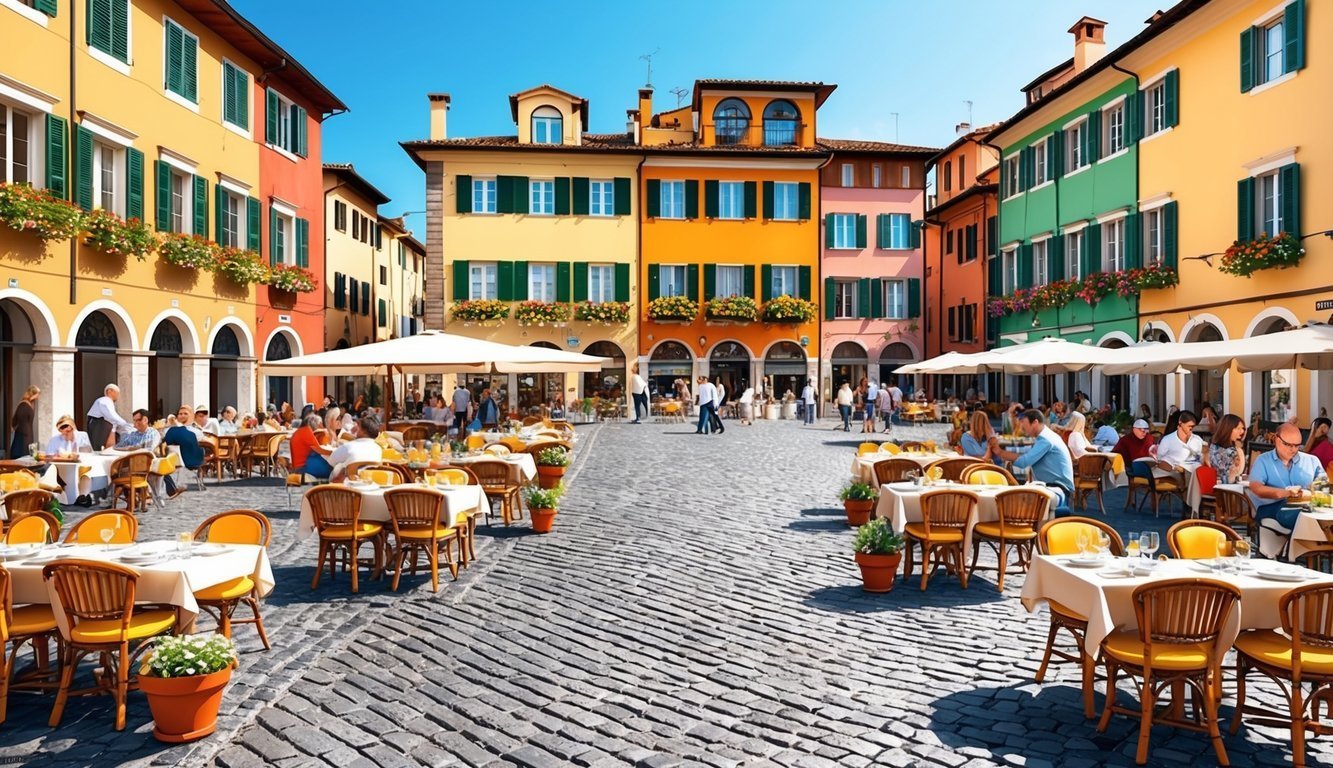If you’re planning a trip to Italy, exploring the charming small towns can offer you a unique experience.
These towns showcase rich history, stunning architecture, and delicious local cuisine. Discovering these hidden gems will give you a taste of authentic Italian life beyond the busy tourist spots.
In this article, you will learn about three of the most delightful small towns in Italy.
Each town has its own character and charm, waiting for you to explore.
Whether you’re interested in ancient castles, picturesque landscapes, or cozy eateries, these towns have something special to offer.
1) Alberobello
Alberobello is famous for its unique trulli houses.
These stone buildings have conical roofs and are a sight to see.
Walking through the streets feels like stepping into a fairy tale.
The town is a UNESCO World Heritage site.
You can explore charming narrow streets lined with shops and cafes.
Don’t miss trying local food and buying handmade souvenirs.
You can also visit the Andy Warhol exhibit, which runs until January 2025.
There’s a lot of art and culture to enjoy here, making it a perfect spot for creative souls.
Alberobello is not just about buildings.
It’s also a place that cares for its community and environment.
You might come across campaigns focused on helping stray animals.
Rating: 4.7 (214 reviews)
Location: Metropolitan City of Bari, Italy
Website: Visit Website
2) Brisighella
Brisighella is a lovely town located in the Province of Ravenna, Italy.
It sits on top of a small hill, surrounded by beautiful countryside.
The views from here are stunning and perfect for taking photos.
As you walk through the narrow streets, you’ll notice the charming medieval buildings.
The town is known for its unique three hills topped with castles and church towers.
Each one offers a glimpse into the town’s rich history.
You can also enjoy local foods and wines in cozy restaurants.
The area is famous for its olive oil, which you can taste at various shops.
Exploring Brisighella feels like stepping back in time.
This hidden gem is less crowded than other tourist spots, making it a relaxing visit.
Don’t forget to explore the local markets and shops for unique souvenirs.
Rating: 4.7 (214 reviews)
Location: Brisighella
Contact:
Website: Visit Website
3) Civita di Bagnoregio
Civita di Bagnoregio is a small, ancient town in Italy known for its stunning views and unique location.
Perched on a hilltop, the town overlooks beautiful valleys and hills, making it a perfect spot for photos.
The town is often called “the dying town” because of its eroding cliffs, but it still holds a special charm.
You can reach Civita by crossing a long footbridge.
This bridge leads you into the town, where you’ll find narrow streets lined with lovely stone buildings.
Exploring these paths feels like stepping back in time.
Be sure to look for the beautiful square at the center, which is perfect for relaxing.
Civita di Bagnoregio is also known for its delicious local food.
You can enjoy traditional dishes and wines in cozy restaurants.
The local cuisine reflects the rich culture and history of the area.
When visiting, take time to enjoy the views from high points in the town.
The sunset here is especially breathtaking and makes for a memorable experience.
Rating: 4.7 (214 reviews)
Location: Civita di Bagnoregio
Contact:
Website: Visit Website
Exploring Local Culture
When you visit the charming small towns in Italy, you’re in for a treat.
The local culture is rich with vibrant festivals and mouthwatering cuisine that reflect the area’s history and traditions.
Let’s dive into two key aspects that make these towns special.
Festivals and Traditions
Local festivals bring communities together and showcase the heart of Italian culture.
In many small towns, you’ll find celebrations that honor saints, harvests, or regional crafts.
For example, the Palio di Siena is a famous horse race held twice a year in Siena, combining excitement with deep-rooted traditions.
In other towns, you could experience Feast of San Giovanni, complete with music, parades, and fireworks.
These events often feature colorful costumes and lively street performances.
Participating in such festivals allows you to connect with locals and appreciate their customs.
Cuisine and Local Dishes
Italian cuisine varies widely from region to region, and each town has its specialties.
When in a small town, don’t miss trying local dishes made from fresh ingredients.
For instance, you may find cicoria ripassata (sautéed chicory) or cappelletti, pasta filled with meat, that are popular in certain areas.
Markets are essential to the culture, offering fresh produce, meats, and cheeses.
Be sure to sample the local bread, often baked in wood-fired ovens.
Gelato is a must-have, especially during the warmer months.
Eating at family-run trattorias lets you taste authentic flavors and see how food is prepared with love and tradition.
Historical Background

Italy is home to many charming towns, each with unique stories woven into their streets and buildings.
You’ll find a mix of stunning architecture and historical events that shaped these places.
Here’s a closer look at what makes their past so fascinating.
Architectural Highlights
When you stroll through these towns, the architecture truly stands out.
In Gradisca d’Isonzo, you can see Renaissance influences in its elegant buildings.
Many structures feature beautiful frescoes that tell tales of the town’s past.
Cefalù is famous for its Norman-style cathedral, which dates back to the 12th century.
This stunning structure boasts intricate mosaics that offer a glimpse into the artistry of that time.
The narrow streets of Anghiari are lined with medieval houses, adding to its timeless charm.
The architecture in these towns does more than look pretty; it reflects the history and culture of the regions.
Each building has a story to tell, connecting you to the traditions of Italy.
Significant Historical Events
Each town has its own significant events that shaped their identity. Gradisca d’Isonzo played a strategic role during various conflicts due to its location.
This has contributed to its diverse cultural influences over centuries.
Cefalù has seen its share of historical moments, especially during the Norman conquest, which left an imprint on the local culture and architecture.
Meanwhile, Anghiari is known for the famous Battle of Anghiari in 1440, which was pivotal in asserting Florentine power.
These events are part of what makes these towns so special.
They offer a window into the past, helping you understand the present-day culture and vibe of each place.
Getting Around
Exploring small towns in Italy can be a delightful experience, especially when you know how to navigate the local transportation options and adapt to the charm of these places.
With a mix of traditional methods and modern conveniences, getting around can be both easy and enjoyable.
Transportation Options
When visiting small towns in Italy, you have several transportation choices.
Trains connect many towns, making it simple to travel from larger cities.
However, not every small town has a train station.
In those cases, buses are often a reliable alternative.
Car rentals offer flexibility, allowing you to discover hidden gems at your own pace.
Keep in mind that some towns have narrow streets, so a compact car is usually best.
Walking is a favorite way to explore.
Many town centers are pedestrian-friendly, making it easy to soak in the sights and sounds.
Tips for Navigating Small Towns
To make the most of your visit, consider these helpful tips.
-
Maps and Apps: Download offline maps on your phone. This can help you find your way without relying on data. Local tourism websites might also provide useful resources.
-
Ask Locals: Don’t hesitate to ask locals for directions. Italians are generally friendly and happy to help you find your way.
-
Time Your Visits: Some areas may get busy during peak hours, so visiting early or later in the day can enhance your experience.
Frequently Asked Questions

When exploring the charming small towns of Italy, you might have some questions in mind.
From hidden gems to culinary delights, here are some answers to guide your travels.
What are some must-visit hidden gems in rural Italy?
If you’re looking for hidden gems, consider visiting towns like Brisighella.
This picturesque village is known for its beautiful landscapes and historic towers.
Another great option is Civita di Bagnoregio, perched on a hill, offering stunning views and a unique atmosphere.
Which Italian small towns offer the best culinary experiences?
Food lovers should not miss Alberobello, famous for its delicious Puglian cuisine.
Here, you can enjoy dishes made with local ingredients, including fresh seafood and handmade pasta.
Brisighella is also known for its olive oil and unique dishes that delight every palate.
In which Italian seaside towns can you enjoy authentic local charm?
For a charming seaside experience, Tropea is hard to beat.
It boasts breathtaking beaches and local cuisine.
While not mentioned earlier, it still offers that authentic small-town feel that many seek.
The coastal views will leave you captivated.
Where can you find the most picturesque countryside in Italy?
The countryside around Brisighella presents stunning landscapes dotted with vineyards and olive groves.
If you wander through the hills, you will discover breathtaking views that are perfect for photos.
Each season offers a new perspective of its beauty.
Which lesser-known Italian villages are ideal for a peaceful living?
You might find tranquillity in places like Civita di Bagnoregio.
This remote village allows you to disconnect from the hustle and bustle.
Its unique charm and serene environment make it perfect for peaceful living.
Can you name some small Italian towns rich in history and culture?
Alberobello stands out for its unique trulli houses, reflecting a rich heritage.
You can explore the streets to learn about the local customs.
Civita di Bagnoregio also offers a deep sense of history with its ancient architecture and fascinating stories.




